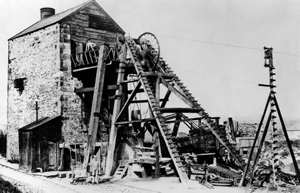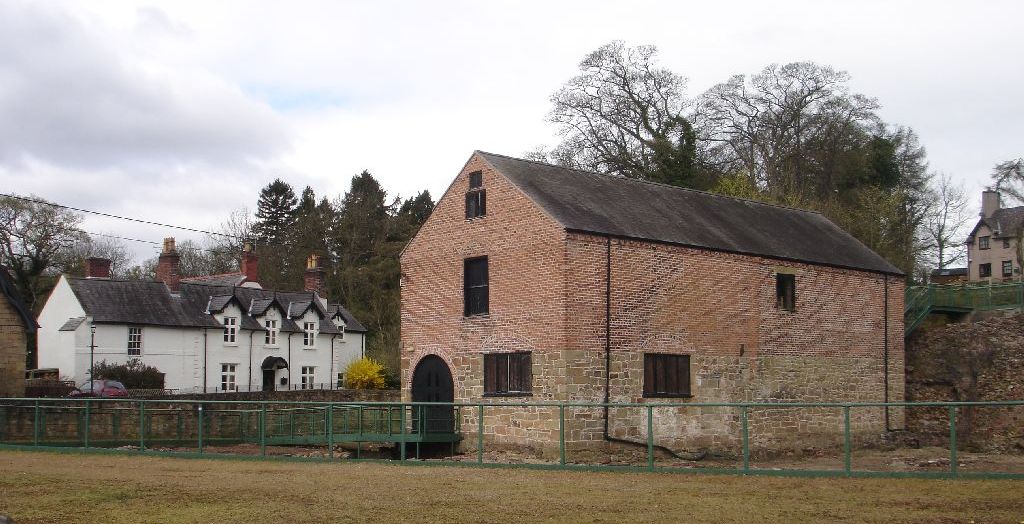|
Clywedog Trail
The Clywedog Trail is a footpath close to Wrexham in Wales. Starting at the Minera Lead Mines and running to King's Mills it follows the course of the River Clywedog. It is a haven for walking, relaxation and enjoying the peace of the wildlife. It is said that the Clywedog Valley was the Silicon Valley of the 18th century, as it was there that British ironmaking began in 1670, smelting iron ore with coke began in 1721 and John Wilkinson set up shop in 1761. For many years the area was one of the most important iron manufacturing centres in the world. Sights Sights passed include: * Minera Lead Mines * Nant Mill * Plas Power Church *Offa's Dyke and Plas Power Woods *Bersham Ironworks *Bersham *Erddig Erddig Hall ( cy, Neuadd Erddig; or simply Erddig; ) is a Grade-I listed National Trust property in Wrexham, Wales. Standing south of Wrexham city centre, it comprises a country house built during the 17th and 18th centuries amidst a 1,900 ... *King's Mills Exter ... [...More Info...] [...Related Items...] OR: [Wikipedia] [Google] [Baidu] |
Wrexham
Wrexham ( ; cy, Wrecsam; ) is a city and the administrative centre of Wrexham County Borough in Wales. It is located between the Welsh mountains and the lower Dee Valley, near the border with Cheshire in England. Historically in the county of Denbighshire, and later the county of Clwyd in 1974, it has been the principal settlement of Wrexham County Borough since 1996. Wrexham has historically been one of the primary settlements of Wales. At the 2011 Census, it had an urban population of 61,603 as part of the wider Wrexham built-up area which made it Wales's fourth largest urban conurbation and the largest in north Wales. The city comprises the local government communities of Acton, Caia Park, Offa and Rhosddu. Wrexham's built-up area extends further into villages like Bradley, Brymbo, Brynteg, Gwersyllt, New Broughton, Pentre Broughton and Rhostyllen. Wrexham was likely founded prior to the 11th century and developed in the Middle Ages as a regional centre for t ... [...More Info...] [...Related Items...] OR: [Wikipedia] [Google] [Baidu] |
Wales
Wales ( cy, Cymru ) is a country that is part of the United Kingdom. It is bordered by England to the east, the Irish Sea to the north and west, the Celtic Sea to the south west and the Bristol Channel to the south. It had a population in 2021 of 3,107,500 and has a total area of . Wales has over of coastline and is largely mountainous with its higher peaks in the north and central areas, including Snowdon (), its highest summit. The country lies within the north temperate zone and has a changeable, maritime climate. The capital and largest city is Cardiff. Welsh national identity emerged among the Celtic Britons after the Roman withdrawal from Britain in the 5th century, and Wales was formed as a kingdom under Gruffydd ap Llywelyn in 1055. Wales is regarded as one of the Celtic nations. The conquest of Wales by Edward I of England was completed by 1283, though Owain Glyndŵr led the Welsh Revolt against English rule in the early 15th century, and briefly re-establis ... [...More Info...] [...Related Items...] OR: [Wikipedia] [Google] [Baidu] |
Minera Lead Mines
The Minera Lead Mines were a mining operation and are now a country park and tourist centre in the village of Minera near Wrexham, in Wrexham County Borough, Wales. History The first written record of lead mining at Minera dates back to 1296, when Edward I of England hired miners from the site to work in his new mines in Devon. Not all of them vacated the area, however, as mining went on until the Black Death in 1349, when it ended. In 1527, two men bought the rights to mine on the site, but deeper workings were unworkable due to the presence of underground rivers, and the inability to prevent flooding. The inability to pay for steam engines to pump out water closed the mines again until 1845, when John Taylor & Sons, mining agents from Flintshire, formed the Minera Mining Company. They were able to build a stationary steam engine on site, and also blast caves from down in the valley into the mines, for extra drainage. The steam engine was a Cornish engine (i.e. a Beam engine ... [...More Info...] [...Related Items...] OR: [Wikipedia] [Google] [Baidu] |
King's Mills, Wrexham
Kings or King's may refer to: *Monarchs: The sovereign heads of states and/or nations, with the male being kings *One of several works known as the "Book of Kings": **The Books of Kings part of the Bible, divided into two parts **The ''Shahnameh'', an 11th-century epic Persian poem **The Morgan Bible, a French medieval picture Bible **The Pararaton, a 16th-century Javanese history of southeast Asia *The plural of any king Business * Kings Family Restaurants, a chain of restaurants in Pennsylvania and Ohio * Kings Food Markets, a chain supermarket in northern New Jersey * King's Favourites, a brand of cigarettes *King's Variety Store, a chain of stores in the USA * King's (defunct discount store), a defunct chain of discount stores in the USA Education *King's College (other), various colleges * King's School (other), various schools * The King's Academy (other), various academies Electoral districts * King's (New Brunswick electoral district) (1867 ... [...More Info...] [...Related Items...] OR: [Wikipedia] [Google] [Baidu] |
River Clywedog
The River Clywedog is a river in Wrexham County Borough, Wales. Its uses have been watering crops, powering industrial machinery but is now used as walking trails or geography trips. The river originates to the west of Wrexham, and joins the River Dee some four miles south east of the city. Course of the river The river Clywedog rises in the hills west of the village of Minera. After flowing through Minera it turns south-east, past Coedpoeth, Bersham and Rhostyllen and through the Erddig Country Park, then east, passing slightly to the south of Wrexham. There is a path along the entire river bank from Minera to Wrexham. After passing the Wrexham industrial estate, the river joins the River Dee near the English/Welsh border. History During the 18th and early 19th centuries there were 17 watermills along the river: fulling mills for preparing cloth, mills for grinding corn and malt, and paper mills. Large waterwheels powered the bellows blasting air into the iron furnaces ... [...More Info...] [...Related Items...] OR: [Wikipedia] [Google] [Baidu] |
Silicon Valley
Silicon Valley is a region in Northern California that serves as a global center for high technology and innovation. Located in the southern part of the San Francisco Bay Area, it corresponds roughly to the geographical areas San Mateo County and Santa Clara County. San Jose is Silicon Valley's largest city, the third-largest in California, and the tenth-largest in the United States; other major Silicon Valley cities include Sunnyvale, Santa Clara, Redwood City, Mountain View, Palo Alto, Menlo Park, and Cupertino. The San Jose Metropolitan Area has the third-highest GDP per capita in the world (after Zurich, Switzerland and Oslo, Norway), according to the Brookings Institution, and, as of June 2021, has the highest percentage of homes valued at $1 million or more in the United States. Silicon Valley is home to many of the world's largest high-tech corporations, including the headquarters of more than 30 businesses in the Fortune 1000, and thousands of startup com ... [...More Info...] [...Related Items...] OR: [Wikipedia] [Google] [Baidu] |
John Wilkinson (industrialist)
John "Iron-Mad" Wilkinson (1728 – 14 July 1808) was an English industrialist who pioneered the manufacture of cast iron and the use of cast-iron goods during the Industrial Revolution. He was the inventor of a precision boring machine that could bore cast iron cylinders, such as cannon barrels and piston cylinders used in the steam engines of James Watt. His boring machine has been called the first machine tool. He also developed a blowing device for blast furnaces that allowed higher temperatures, increasing their efficiency, and helped sponsor the first iron bridge in Coalbrookdale. He is notable for his method of cannon boring, his techniques at casting iron and his work with the government of France to establish a cannon foundry. Biography Early life John Wilkinson was born in Little Clifton, Bridgefoot, Cumberland (now part of Cumbria), the eldest son of Isaac Wilkinson and Mary Johnson. Isaac was then the potfounder at the blast furnace there, one of the first to u ... [...More Info...] [...Related Items...] OR: [Wikipedia] [Google] [Baidu] |
Bersham
Bersham ( cy, Y Bers) is a village in Wrexham County Borough, Wales, that lies next to the River Clywedog, and is in the community of Esclusham. Bersham was historically a major industrial centre of the area, but despite this the village still retains a rural feeling. Historical significance The village holds special importance for economic historians, for not only did it house the workshops of the skilled Davies brothers, it was one of the cradles of the Industrial Revolution. This is the place where British iron making began in 1670, where smelting iron ore with coke began in 1721, and where John Wilkinson, the 'Iron Mad' pioneer of the Industrial Revolution, set up shop in 1761. For many years the area was one of the most important iron manufacturing centres in the world. The Bersham Ironworks Museum tells the story of the man who bored cannon for the American War of Independence and cylinders for James Watt's revolutionary steam engine that changed the face of the wor ... [...More Info...] [...Related Items...] OR: [Wikipedia] [Google] [Baidu] |
Offa's Dyke
Offa's Dyke ( cy, Clawdd Offa) is a large linear earthwork that roughly follows the border between England and Wales. The structure is named after Offa, the Anglo-Saxon king of Mercia from AD 757 until 796, who is traditionally believed to have ordered its construction. Although its precise original purpose is debated, it delineated the border between Anglian Mercia and the Welsh kingdom of Powys. The earthwork, which was up to wide (including its flanking ditch) and high, traversed low ground, hills and rivers. Today it is protected as a scheduled monument. Some of its route is followed by the Offa's Dyke Path, a long-distance footpath that runs between Liverpool Bay in the north and the Severn Estuary in the south. Although the Dyke has conventionally been dated to the Early Middle Ages of Anglo-Saxon England, research in recent decades – using techniques such as radioactive carbon dating – has challenged the conventional historiography and theories about the e ... [...More Info...] [...Related Items...] OR: [Wikipedia] [Google] [Baidu] |






